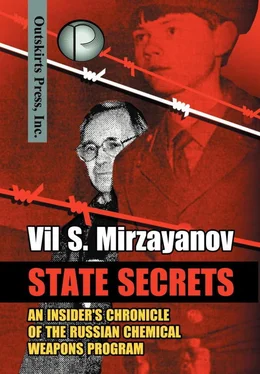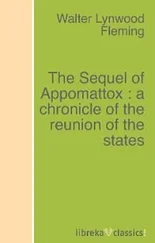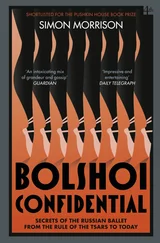According to the safety rules, the ventilation was shut down at 6 PM and started up again at 8 AM the next day, one hour before the working day began. These requirements were supposed to provide enough time to clear the working rooms of chemical agent vapors that were released during the night, while the ventilation system wasn’t working. The Safety Department ordered me to research the dangers posed by these procedures. As a model, I used a non-toxic substance and the tracer sulfur hexafluoride, which has far less adsorption on the walls of the hoods and working room surfaces than any of the chemical agents. I discovered that the tracer was released in significant amounts in the closed hood, diffusing into the room and becoming adsorbed to the walls during the night time. The chemical agents were less volatile than the safer model, so they were more likely to adsorb to the workroom walls and surfaces at night.
After starting the ventilation up at 8 AM, an initial measurement was taken at 9 AM the next day. By 5 PM, the concentration of sulfur hexafluoride was equal to 70% its original value that morning, proving that the model was desorbing slowly. So, the working rooms were never free of any traces of chemical agents, unless the ventilators were operating round the clock.
My findings did not prompt the management of GOSNIIOKhT to take any steps to correct this problem, because they could not afford such a luxury as a permanently working ventilation system.
At that time, the problem of purification of the exhaust air, which was ventilated from the buildings of GOSNIIOKhT, had not been resolved in any way at all. I am not sure that this problem has been solved, even today. Activated charcoal cannot be safely used to purify these emissions, as it is a flammable solid, which is extremely dangerous. It is absolutely clear that a fire at such a plant could have catastrophic consequences.
This was the reason why the exhaust ventilation at GOSNIIOKhT was not equipped with filtering devices, and practically all of the air from the production and laboratory areas was emitted into the atmosphere without any purification. [54] The Main Laboratory Building was constructed in 1961. In 1987, I performed chromatomass-spectrometric analysis of water samples from the artesian well beneath the pilot plant facility. This well supplied many buildings of GOSNIIOKhT with water. My analysis showed the presence of many sulfur-containing decomposition products of mustard gas in significant quantities. Workers operating the excavating machines to prepare the site for new buildings experienced symptoms of poisoning from unknown substances. At last several events with serious poisoning of workers convinced the chief engineer to order the excavations to proceed under the supervision of experienced chemists, sometimes in gasmasks.
Certainly they did try to solve this problem by using inorganic adsorbents, aluminum oxide in particular. Victor Aborkin, a senior researcher from the Department D, was obsessed with this idea, which was the topic of his master’s thesis.
Having only a very vague concept of the basics of adsorption, this inventor managed to attract the attention of Guskov and Golubkov, the Deputy Minister for Chemical Industry, to his idea. Then he enlisted the help of those two bosses, who became his coauthors, and he aggressively and persistently pushed his idea further along. Aborkin began promoting this adsorbent project in Workshop N 34, in the Volgograd Scientific Production Association where soman was produced.
When I visited this workshop in 1984, I was shown a big adsorber outside the building where aluminum oxide had turned into an absolutely airproof monolith. It turned out to be a lesson on adsorption basics for the unlucky speculators, but they had already received considerable sums of money for their “invention”, so they didn’t care.
When I returned to Moscow, I decided to make a more thorough check of this adsorbent. As a result of this test, it was proved that after adsorption, soman could exist in its solid state indefinitely without degrading. Moreover, aluminum oxide stopped adsorbing soman after acidic vapor, or just hydrogen chloride gas or clorine, was passed through it. The concentration of hydrochloric acid in the atmosphere of the Volgograd plant exceeded the permissible standards by hundreds of times. So this huge monolith had entirely stopped working as a “filter” a long time before. Still, it contained huge quantities of the dangerous chemical agent.
The plants for producing phosphorous chloride, which was a precursor for the synthesis of phosphoorganic compounds including soman and sarin, were continuously secreting unbroken clouds of chlorine and hydrogen chloride into the open air.
I went on a number of business trips to our Volgograd branch and to the Volgograd Institute of Toxicology and Professional Pathology. Their buildings were located on the territory of the NPO “Khimprom”. Along with the employees of these institutions, I was repeatedly “assaulted” by chlorine gas. In this place it was sometimes even difficult to see each other in the workrooms, due to the extremely high gas content. Only a gas mask could help, and gas masks were provided to all the visitors, who had to wear them until they left the territory of the NPO enterprise.
Sometimes distance could not save you from a gas attack, even if you were far away from the plant. I remember that during one of my first visits to Volgograd, we stayed in the Beketovka settlement, which is 7 kilometers from “Khimprom”. In the middle of one summer night, we woke up suffocating. Immediately we understood from the smell that we were being poisoned with chlorine. We could save ourselves only by closing all the windows and covering them with wet sheets and blankets.
The residents of the settlement and of other regions located within the zone of the gas attack could breathe somewhat easily only when the wind shifted direction. If the wind was blowing from the plant, which is on the banks of the Volga River, it was a real disaster. No wonder all this led to massive protests by the inhabitants, even during times of Communist stagnation. Unfortunately, the protests did not produce any tangible results. From time to time, party leaders simply found some scapegoat, leaving the existing production process unchanged.
Aluminum oxide was equally unsuitable as a filtering adsorbent for purifying the emissions from GOSNIIOKhT. In the laboratory rooms, calcium hypochlorite and hydrochloric acid (the solution of hydrogen chloride gas in water) are used almost everywhere on a daily basis to destroy chemical agents, to neutralize chemicals on the laboratory glassware, gloves and other items for individual protection. Since aluminum oxide is very quickly deactivated by acid and chlorine, it would be absolutely useless in a filter.
Additionally, there is another substantial obstacle that prevents the use of any filters in the path of the air vented into the atmosphere.
According to the safety standards for working with chemical agents, the linear velocity of the air sucked by the ventilation into the laboratory exhaust hood should be at least 1.0 meter per second. It is believed that only this air speed, as measured at the hood gate when opened to 40 centimeters above the surface of a table, can guarantee certain safety to people working with chemical agents. Additional airflow is forced into each room through the ventilation with air-blowers located close to the laboratory building, in order not to create a rarefied atmosphere during the constant suction through the exhaust hood. The pressure equilibrium between outgoing and incoming air volumes is maintained in this way. Every room is equipped with its own ventilator fan, which constantly drives air out of the building. The capacity of each ventilator is calculated for maintaining the necessary exhaust air velocity and no more than that.
Читать дальше












